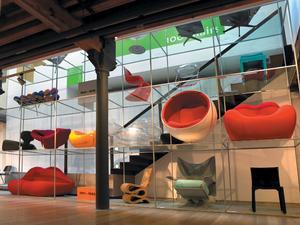Vitra Design Museum has one of the biggest and most important collections of modern furniture design. The exhibition 100 years – 100 chairs provides us with the opportunity to contemplate the museum's most beautiful and significant pieces. It all began in the latter half of the 19th century with curved wooden furniture which lent itself to mass-production. Design played a significant role in cultural development at the beginning of the 20th century. Gerrit Rietveld designed furniture with simple lines, while Marcel Breuer created the first tubular steel chairs. This lightness in shape was subsequently a source of inspiration for Alvar Alto, who was the first to use plywood, and for Jean Prouve, who started to use techniques and materials which had previously only been used by the aeronautical industry.
Following the Second World War. American designers began to collaborate closely with industry. Designers like Charles Eames, Ero Saarinen and Harry Bertoia came up with designs which would be used for the mass production of furniture for American homes. Design became a key element of daily life. At that time in Europe, furniture design was a developing mainly in Italy and Scandinavia. Nonetheless, the objective was still the same as that in America, namely to make designer goods more accessible to the general public. Hans Wegner and Arne Jacobsen were forerunners in Scandinavian countries in creating wooden furniture, while the Italians turned their attention to more novel materials like plastic.
The considerable malleability of these materials, together with the development of new types of foam, gave rise to a wealth of creative fantasy in the sixties. At that time, Pop Art provided a source of inspiration and designers played on form and colour. The main representatives of this trend were Verner Paton and Joe Colombo. Later, in the seventies, designs became even more radical, leading to the emergence of opposition to the rules of Modernism. Groups of designers like Memphis or Archizoom emphasised the amusing and playful nature of forms rather than functionality.

The eighties were marked by a search for both individualism and pluralism, giving rise to a variety of previously unheard of styles. Philippe Starck, Ron Arad and Gaetano Pesce are leading representatives of this trend. A search for simple but innovative shapes and materials characterised the nineties, Frank Gehry and Jasper Morrison being two key figures of this period. Nevertheless, fantasy remains an indispensable criterion in the conception of forms. The work of Ron Arad and Marc Newson, both concerned with functionality and mass-production, bears witness to this fact.
Drawings, sketches and documents belonging to the Vitra Design Museum accompany the chairs on display.
Organised by Graeme Russell
Curated by Vitra Design Museum
Curated by Vitra Design Museum




